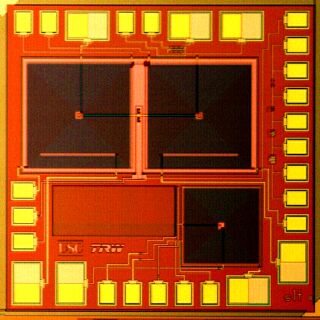USC ULT SQUIDs
| Research Topics |
The term SQUID stands for Superconducting QUantum Interference Device. The operation of SQUIDs requires temperatures low enough to allow the materials to become superconducting. Our SQUIDs are made from niobium and work well at temperatures at or below the temperature of boiling liquid helium (4.2 Kelvin). The figure below is an actual DC - SQUID.
These SQUIDs are excellent sensors of tiny magnetic fields and electric currents. We employ SQUIDs as very sensitive amplifiers for our very low field NMR measurements of 3He on Grafoil as well for fundamental studies of R-SQUIDs. R-SQUIDs are potentially great candidates for absolute thermometers, but first we need to sort out their dynamical behavior. We have recently successfully built and studied R-SQUIDs, and those results along with some of the techniques for low field NMR are shown in the links on this page.
Development of direct readout DC SQUIDs.
|
